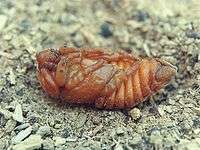European rhinoceros beetle
| European rhinoceros beetle | |
|---|---|
| | |
| Oryctes nasicornis. Male, side view | |
| | |
| Dorsal view | |
| Scientific classification | |
| Kingdom: | Animalia |
| Phylum: | Arthropoda |
| Class: | Insecta |
| Order: | Coleoptera |
| Family: | Scarabaeidae |
| Subfamily: | Dynastinae |
| Genus: | Oryctes |
| Species: | O. nasicornis |
| Binomial name | |
| Oryctes nasicornis (Linnaeus, 1758) | |
The European rhinoceros beetle (Oryctes nasicornis) is a large flying beetle belonging to the subfamily Dynastinae.


Subspecies
- Oryctes nasicornis afghanistanicus Endrödi, 1938
- Oryctes nasicornis chersonensis Minck, 1915
- Oryctes nasicornis corniculatus Villa & Villa, 1833
- Oryctes nasicornis edithae Endrödi, 1938
- Oryctes nasicornis grypus (Illiger, 1803)
- Oryctes nasicornis hindenburgi Minck, 1915
- Oryctes nasicornis holdhausi Minck, 1914
- Oryctes nasicornis illigeri Minck, 1915
- Oryctes nasicornis kuntzeni Minck, 1914
- Oryctes nasicornis latipennis Motschulsky, 1845
- Oryctes nasicornis mariei (Bourgin, 1949)
- Oryctes nasicornis nasicornis (Linnaeus, 1758)
- Oryctes nasicornis ondrejanus Minck, 1916
- Oryctes nasicornis polonicus Minck, 1916
- Oryctes nasicornis przevalskii Semenow & Medvedev, 1932
- Oryctes nasicornis punctipennis Motschulsky, 1860
- Oryctes nasicornis shiraticus Endrödi & Petrovitz, 1974
- Oryctes nasicornis transcaspicus Endrödi, 1938
- Oryctes nasicornis turkestanicus Minck, 1915
Description
Oryctes nasicornis reach a length of 20–40 millimetres (0.79–1.57 in), with a maximum of 47 millimetres (1.9 in).[1] It is one of the largest beetles found in Europe. Elytra are reddish brown with a glazed appearance, while head and pronotum are slightly darker. The underside of the body and the legs are covered with long red hair. It is a sexually dimorphic species. The male's head is topped by a long curved horn (hence its common name), while the females have no horns.
Dim, the beetle from the Disney and Pixar film, A Bug's Life, is a European rhinoceros beetle.
Distribution
Oryctes nasicornis inhabits the Palaearctic region, excluding the British Isles. It is the only representative of the Dynastinae family found in Northern Europe. It is widespread in the Mediterranean basin up to Pakistan, the Near East and North Africa.
Habitat
The rhinoceros beetle lives on wood, and the large larvae can be found in rotting wood stumps and around sawdust. At the margin of its distribution, the beetle is often found in connection with sawmills and horse racing tracks.
Life cycle
The larvae grow in decaying plants feeding on woody debris (xylophagy), generally non-resinous. They can reach a length of 60–100 millimetres (2.4–3.9 in). The development period lasts 2 to 3 or 4 years. The adult size can be influenced by the quality and abundance of food.
The mammoth wasp (Megascolia maculata) is a parasite of European rhinoceros beetle larvae. A female wasp lays one egg inside the beetle larva; when the egg hatches, the wasp larva will feed on the beetle larva.
The adult beetle emerges at the end of March, April or May, and lives several months until autumn. It occurs mainly during the months of June and July and it is very active, flying at dusk and by night, attracted by the lights. These beetles do not feed, consuming during the few weeks of adult life reserves accumulated during the larval stages.
 Life cycle. From «Fauna Germanica: Die Käfer des deutschen Reiches» |
 Egg |
 Pupa |
 Adult |
References
- R.-P. Dechambre & G. Lachaume (2001). The genus Oryctes (Dynastidae). The Beetles of the World. 27. Hillside Books, Canterbury.
Notes
- ↑ Marek Bunalski. Die Blatthomkäfer Mitteleuropas Coleoptera, Scarabaeoidea. Bratislava, 1999
External links
| Wikispecies has information related to: Oryctes nasicornis |
| Wikimedia Commons has media related to Oryctes nasicornis. |
- Oryctes nasicornis ondrejanus
- BioLib - Taxonomic tree of plants and animals with photos
- Fauna Europaea
- Butterfly photo, print and images, Oryctes nasicornis